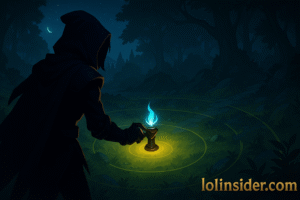Runes are one of the most important systems in League of Legends, allowing players to customize their champions with unique bonuses, keystones, and stat boosts. For beginners, however, the rune system can feel overwhelming.
This Complete Guide to Runes for Beginners will walk you through everything you need to know—what runes are, how to set them up, which ones to pick for your champions, and some easy starter pages to help you climb.
What Are Runes in League of Legends?
Runes are customizable perks you choose before a game starts. They modify your champion’s playstyle by giving you:
- Extra damage or healing.
- More defenses like armor or magic resist.
- Utility boosts like cooldown reduction, movement speed, or gold income.
They are divided into:
- Keystones – The most impactful choice (biggest bonuses).
- Secondary Runes – Smaller perks that support your playstyle.
- Stat Shards – Minor customizable boosts to damage, defense, or mobility.
The Five Primary Rune Paths
There are five rune paths, each designed for specific champion types.
1. Precision (DPS & Consistency)
- Focus: Sustained damage, attack speed, and healing.
- Ideal For: ADCs, duelists, fighters.
- Example Keystones:
- Conqueror – Extra AD/AP in fights, great for extended trades.
- Lethal Tempo – Increased attack speed for ADCs like Jinx or Vayne.
- Press the Attack – Bonus damage after three autos, great for early trades.
2. Domination (Burst Damage)
- Focus: Burst, assassination, and vision control.
- Ideal For: Assassins, aggressive junglers.
- Example Keystones:
- Electrocute – Burst combo damage (Zed, Ahri, Evelynn).
- Dark Harvest – Snowball rune that scales with stacks (Katarina, Kha’Zix).
- Hail of Blades – Faster early autos (Jhin, Kalista).
3. Sorcery (Ability Power & Utility)
- Focus: Ability power, poke, mana sustain.
- Ideal For: Mages, poke supports.
- Example Keystones:
- Summon Aery – Extra poke and shielding (Lux, Karma).
- Arcane Comet – Poke-focused mages like Xerath or Ziggs.
- Phase Rush – Movement speed for kiting mages (Ryze, Cassiopeia).
4. Resolve (Tankiness & Healing)
- Focus: Defense, sustain, and crowd control.
- Ideal For: Tanks, bruisers, engage supports.
- Example Keystones:
- Grasp of the Undying – Sustain and scaling for tanks (Maokai, Shen).
- Aftershock – Burst resistances after CC (Leona, Nautilus).
- Guardian – Shields for allies (Lulu, Braum).
5. Inspiration (Utility & Creativity)
- Focus: Utility, sustain, and unique playstyles.
- Ideal For: Utility supports, experimental builds.
- Example Keystones:
- Glacial Augment – Slows enemies with active items (Senna, Ashe support).
- Unsealed Spellbook – Swap Summoner Spells mid-game (pro play favorite).
- First Strike – Bonus gold and damage for poke champs (Ezreal, Viktor).
Secondary Paths and Stat Shards
In addition to your primary rune path, you choose a secondary path with two additional runes. For example:
- A Vayne player may take Precision (main) with Domination (secondary) for lifesteal and burst.
- A Malphite player may take Resolve (main) with Sorcery (secondary) for tankiness and poke.
Stat shards offer extra customization:
- Offense: Adaptive Force, Attack Speed, or Ability Haste.
- Defense: Armor, Magic Resist, or Health.
- Flexibility: Movement speed or scaling stats.
Beginner-Friendly Rune Pages
Here are easy-to-use rune setups for beginners:
ADC (Marksman) – Example: Ashe, Jinx
- Primary Path: Precision (Lethal Tempo, Presence of Mind, Legend: Bloodline, Coup de Grace).
- Secondary Path: Domination (Taste of Blood, Treasure Hunter).
- Stat Shards: Attack Speed, AD, Armor.
Mid Lane Mage – Example: Lux, Annie
- Primary Path: Sorcery (Arcane Comet, Manaflow Band, Transcendence, Scorch).
- Secondary Path: Inspiration (Biscuit Delivery, Cosmic Insight).
- Stat Shards: AP, AP, Magic Resist.
Top Lane Tank – Example: Malphite, Shen
- Primary Path: Resolve (Grasp of the Undying, Demolish, Second Wind, Overgrowth).
- Secondary Path: Sorcery (Manaflow Band, Transcendence).
- Stat Shards: Armor, Health, Health.
Jungle – Example: Warwick, Amumu
- Primary Path: Domination (Electrocute or Predator, Sudden Impact, Eyeball Collection, Relentless Hunter).
- Secondary Path: Precision (Triumph, Legend: Tenacity).
- Stat Shards: AD, Armor, Health.
Support – Example: Leona, Lulu
- Engage Support (Leona): Resolve + Inspiration.
- Enchanter (Lulu): Sorcery + Resolve.
Tips for Mastering Runes
- Start Simple – Use recommended rune pages in the client.
- Adjust Slowly – Once comfortable, swap one rune at a time.
- Follow the Meta – Use OP.GG or U.GG to see high-win-rate rune setups.
- Understand Matchups – Some runes are situational (e.g., Bone Plating vs burst lanes).
- Experiment in Normals – Test pages before ranked games.
Common Mistakes Beginners Make with Runes
- Copying pro players’ rune pages without understanding them.
- Forgetting to change rune pages before games.
- Picking scaling runes when early-game power is needed.
- Ignoring stat shards.
- Overcomplicating pages instead of keeping them simple.
Final Thoughts
Runes may seem complex at first, but with practice, they become second nature. This Complete Guide to Runes for Beginners shows you the foundation:
- Learn the five rune paths.
- Start with simple, effective pages.
- Adjust as you gain experience and confidence.
With the right rune setup, your champions will feel stronger, your matchups will be easier, and your climb will become much smoother.
Remember: the best rune page is the one that matches your playstyle. Master the basics here, and you’ll be on your way to creating optimized setups for every game.







